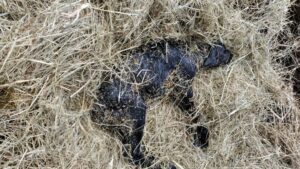
A premature live calf demonstrating the classic signs and pose of selenium deficiency
March 19, 2021
What is a dummy calf? This condition refers to a newborn calf that has no voluntary muscle movement. Legs are stiff and unbendable. The calf is either born dead or presents with labored breathing and dies soon after parturition. This is due to the heart muscle being affected. Calves are often pre-mature in appearance with significantly lower birth weights than expected.
Less deficient calves are able to stand but have low suckle response and difficulty bending legs to nurse. Calves often present with knuckled under forefeet; a distinguishing feature as opposed to a ‘dwarfism’ trait.
The condition and symptoms are not limited to cattle. It is a condition that also affects pigs, sheep, goats, alpacas, lamas, and horses. In animals that can receive a selenium injection, a positive response can be as soon as six hours after administration. No response in calves is indicative of a genetic deformity or even a difficult birth.
While there are several probable causes to consider when finding an unthrifty or pre-mature newborn, a major concern is selenium deficiency in last year’s hay crop.
Selenium deficiency suspected: Also known as white-muscle disease, selenium deficiency is suspected in this March 2021 pre-mature calf born to a ten-year-old highly productive angus brood cow in body condition score 5 on a farm in Pennsylvania. Veterinarian and local farmer reports indicate selenium deficiency in calves and lambs are occurring. Selenium deficiency was identified in the 2021 forage crop as most likely to be of concern in the areas of the Mid-Atlantic that suffered an exceptional to extreme drought in 2020; coupled with similar conditions in 2019; on top of back-to-back excessive rainfall the prior two years; and have known selenium deficient soils. Because selenium and vitamin E are interdependent, the 2020 hay crop is most likely vitamin E deficient as well.
Parts of Pennsylvania and areas of the Mid-Atlantic are known to have selenium deficient soils (USGS, Selenium in Counties of the Conterminous States). Herds confined to these soils have a known history of having white muscle disease calf and lamb crops. The precipitation extremes the last few years in parts of Pennsylvania have resulted in above average low selenium content of grazed and stored forages. Livestock accumulate and store selenium in body fat over time. Although selenium can be supplemented in mineral blocks and mixed into purchased feed as selenium yeast, the intake may not be sufficient after multiple years of selenium deficient forages. It is critical to management to understand: Selenium is a trace nutrient and over supplementation can cause selenium toxicity.
Corrective measures at parturition: If selenium deficiency has been confirmed by forage testing and feed testing, or via blood work. “Non-dairy, breeding beef cows and weanling calves can be given selenium, vitamin E infections (MU-SE®) intramuscularly or subcutaneously administered or on the order of a licensed veterinarian. Discontinue use 30 days before slaughter if for human consumption.” – Merck Animal Health bottle label.
B0-SE® is recommended for “the prevention and treatment of white muscle disease (Selenium-Tocopherol Deficiency) syndrome in calves, lambs, and ewes, and as an aid in the prevention and treatment of Selenium-Tocopherol Deficiency in sows and weanling pigs. Bo-Se should not be administered to pregnant ewes as deaths and abortions may occur.” – Merck Animal Health bottle label.
Corrective measures before parturition; or post-partum: Selenium deficiency impacts re-breeding and can be a cause of infertility. If selenium deficient forages are identified or suspected, have your veterinarian draw blood samples from pregnant cows, post-partum cows and herd sires so that corrective measures can be taken (injection or daily feed supplementation). Correctly supplemented feed can increase selenium levels in soil over time through cattle deposition of manure or field application of manure. Just remember, the dose can become the poison. Incorrectly supplemented feed can result in selenium toxicity and death.

